Visitability Practices Increases Community Inclusion
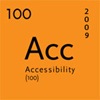 When my parents bought my first electric scooter way back in Grade 8, the world that I could explore on my own grew significantly. That world soon included Beth’s house.
When my parents bought my first electric scooter way back in Grade 8, the world that I could explore on my own grew significantly. That world soon included Beth’s house.
Beth was my first friend in high school and she lived around the corner and up a short block from us. Once I had my scooter, I was able to go independently to Beth’s house, although Mom did do the “Mom-thing†the first time by watching from the corner to make sure I got there okay.
Other than our own house, which was a rancher, Beth’s house was the only house I didn’t need to be carried into. There was a door from the carport into the family room. There was even a small bathroom on the ground flour.
Beth’s house was ahead of its time. Now there is “visitabilityâ€:
…a movement to change home construction practices so that virtually all new single-family homes offer a few specific features that make the home easier for people who develop a mobility impairment to live in and visit. Visitability ensures that everyone, regardless of mobility, will be able to at least visit someone else’s home, use the washroom and exit the home.
(From Visitability: Moving Towards Livable, Sustainable Housing and Communities in Canada – PDF document)
According to the article, the technical requirements include:
- a zero step entrance,
- at least 32-inch clear opening width of main floor doorways, and
- at least a half bath on the main floor.
Visitability practices benefits people with limited mobility and enables seniors to “age in place†with minimal renovations needed. Visitability increases opportunities for social interaction and inclusive, livable communities.
Why is visitability being included in Accessibility 100 – a series focusing on easy-to-implement, free and inexpensive tips for improving accessibility for people with disabilities?
The way for the visitability movement to gain momentum is by first increasing the awareness and interest in the need for this housing construction practice.
From increased awareness and understanding comes increased support:
- for visitability initiatives,
- for changes to bylaws requiring visitable and adaptable housing, such as the bylaws adopted by the District of Saanich, and
- for favouring visitability practices when buying a home.
What opportunities exist to support visitability or to initiate such a practice to increase inclusion in your community?
Accessibility 100 is a series of 100 easy-to-implement, free and inexpensive tips for improving accessibility for people with disabilities. This is a community project. Feel free to leave your comments, questions and ideas for future Accessibility 100 posts.
Get the entire series by subscribing to this blog by filling in the form in the upper right corner or by subscribing to the RSS feed.
If you enjoyed this post, consider buying me a chai tea latte. Thanks kindly.
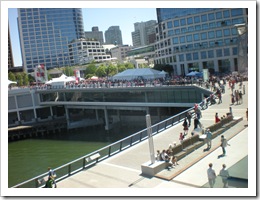
 Making our way through the crowds, we managed to reach
Making our way through the crowds, we managed to reach 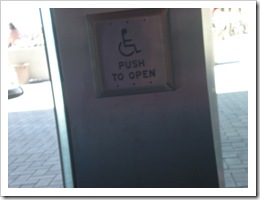 However, for a “green-designed, state-of-the-art facility†that was several hundred million dollars over budget, I was slightly disappointed at the accessibility.
However, for a “green-designed, state-of-the-art facility†that was several hundred million dollars over budget, I was slightly disappointed at the accessibility. 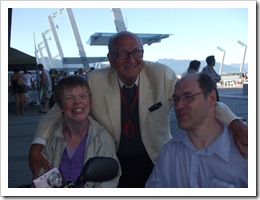 Back outside, we found our way to another stage in time to enjoy
Back outside, we found our way to another stage in time to enjoy 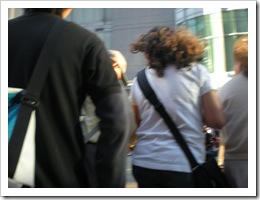
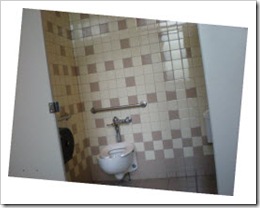 Do you know how long I and millions of other people with disabilities have been dealing with less than accessible washrooms, curb cuts and such? Accessibility isn’t a new concept, yet many, many people still don’t get it until they are personally touched by the need.
Do you know how long I and millions of other people with disabilities have been dealing with less than accessible washrooms, curb cuts and such? Accessibility isn’t a new concept, yet many, many people still don’t get it until they are personally touched by the need. 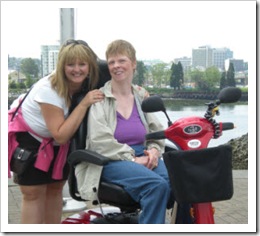 This past Sunday, Darrell and I met a Guiding friend Christine who I hadn’t since my Guiding days, many moons ago! With her partner Mark and their dog Cyrus, the five of us walked and wheeled around the north side of False Creek. We had great time talking, reminiscing and laughing.
This past Sunday, Darrell and I met a Guiding friend Christine who I hadn’t since my Guiding days, many moons ago! With her partner Mark and their dog Cyrus, the five of us walked and wheeled around the north side of False Creek. We had great time talking, reminiscing and laughing. 

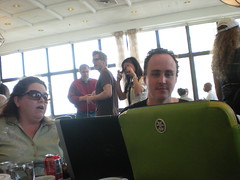
 I drove straight in to the bathroom (rough sketch to the right), but even with my scooter nose right against the far wall, the door wouldn’t close. I backed up and tried pulling in beside the toilet. However, a small table and waste paper basket were next to the toilet – dumb place to put them! I was able to squeeze my scooter in between the table and toilet, barely. But now the metal garbage can was at risk – and I couldn’t reach it to move out of the way. It was either the garbage can or a dire consequence.
I drove straight in to the bathroom (rough sketch to the right), but even with my scooter nose right against the far wall, the door wouldn’t close. I backed up and tried pulling in beside the toilet. However, a small table and waste paper basket were next to the toilet – dumb place to put them! I was able to squeeze my scooter in between the table and toilet, barely. But now the metal garbage can was at risk – and I couldn’t reach it to move out of the way. It was either the garbage can or a dire consequence.  Subscribe via RSS
Subscribe via RSS



